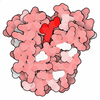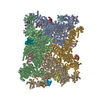[English] 日本語
 Yorodumi
Yorodumi- PDB-9e17: Structure of RyR1 in the primed state in the presence of caffeine... -
+ Open data
Open data
- Basic information
Basic information
| Entry | Database: PDB / ID: 9.0E+17 | ||||||
|---|---|---|---|---|---|---|---|
| Title | Structure of RyR1 in the primed state in the presence of caffeine (reprocessed/reanalyzed from EMPIAR-10997, 7TZC, EMD-26205) | ||||||
 Components Components |
| ||||||
 Keywords Keywords | TRANSPORT PROTEIN / calcium channel / sarcoplasmic reticulum | ||||||
| Function / homology |  Function and homology information Function and homology informationcytoplasmic side of membrane / ATP-gated ion channel activity / terminal cisterna / ryanodine receptor complex / ryanodine-sensitive calcium-release channel activity / CaM pathway / Cam-PDE 1 activation / Sodium/Calcium exchangers / release of sequestered calcium ion into cytosol by sarcoplasmic reticulum / Calmodulin induced events ...cytoplasmic side of membrane / ATP-gated ion channel activity / terminal cisterna / ryanodine receptor complex / ryanodine-sensitive calcium-release channel activity / CaM pathway / Cam-PDE 1 activation / Sodium/Calcium exchangers / release of sequestered calcium ion into cytosol by sarcoplasmic reticulum / Calmodulin induced events / ossification involved in bone maturation / Reduction of cytosolic Ca++ levels / Activation of Ca-permeable Kainate Receptor / CREB1 phosphorylation through the activation of CaMKII/CaMKK/CaMKIV cascasde / Loss of phosphorylation of MECP2 at T308 / CREB1 phosphorylation through the activation of Adenylate Cyclase / cellular response to caffeine / CaMK IV-mediated phosphorylation of CREB / PKA activation / negative regulation of high voltage-gated calcium channel activity / Glycogen breakdown (glycogenolysis) / CLEC7A (Dectin-1) induces NFAT activation / skin development / Activation of RAC1 downstream of NMDARs / negative regulation of ryanodine-sensitive calcium-release channel activity / organelle localization by membrane tethering / mitochondrion-endoplasmic reticulum membrane tethering / autophagosome membrane docking / negative regulation of calcium ion export across plasma membrane / regulation of cardiac muscle cell action potential / presynaptic endocytosis / organelle membrane / Synthesis of IP3 and IP4 in the cytosol / regulation of cell communication by electrical coupling involved in cardiac conduction / Phase 0 - rapid depolarisation / calcineurin-mediated signaling / Negative regulation of NMDA receptor-mediated neuronal transmission / Unblocking of NMDA receptors, glutamate binding and activation / intracellularly gated calcium channel activity / smooth endoplasmic reticulum / RHO GTPases activate PAKs / outflow tract morphogenesis / Ion transport by P-type ATPases / Uptake and function of anthrax toxins / regulation of ryanodine-sensitive calcium-release channel activity / protein phosphatase activator activity / Long-term potentiation / Calcineurin activates NFAT / Regulation of MECP2 expression and activity / DARPP-32 events / catalytic complex / Smooth Muscle Contraction / detection of calcium ion / regulation of cardiac muscle contraction / toxic substance binding / RHO GTPases activate IQGAPs / regulation of cardiac muscle contraction by regulation of the release of sequestered calcium ion / striated muscle contraction / voltage-gated calcium channel activity / cellular response to interferon-beta / Protein methylation / calcium channel inhibitor activity / Activation of AMPK downstream of NMDARs / presynaptic cytosol / skeletal muscle fiber development / Ion homeostasis / regulation of release of sequestered calcium ion into cytosol by sarcoplasmic reticulum / eNOS activation / titin binding / Tetrahydrobiopterin (BH4) synthesis, recycling, salvage and regulation / sperm midpiece / regulation of calcium-mediated signaling / release of sequestered calcium ion into cytosol / voltage-gated potassium channel complex / calcium channel complex / FCERI mediated Ca+2 mobilization / substantia nigra development / sarcoplasmic reticulum membrane / muscle contraction / Ras activation upon Ca2+ influx through NMDA receptor / regulation of heart rate / FCGR3A-mediated IL10 synthesis / cellular response to calcium ion / Antigen activates B Cell Receptor (BCR) leading to generation of second messengers / calyx of Held / sarcoplasmic reticulum / adenylate cyclase activator activity / sarcomere / VEGFR2 mediated cell proliferation / protein serine/threonine kinase activator activity / VEGFR2 mediated vascular permeability / regulation of cytokinesis / spindle microtubule / calcium channel regulator activity / Translocation of SLC2A4 (GLUT4) to the plasma membrane / positive regulation of receptor signaling pathway via JAK-STAT / peptidylprolyl isomerase / peptidyl-prolyl cis-trans isomerase activity / RAF activation / Transcriptional activation of mitochondrial biogenesis Similarity search - Function | ||||||
| Biological species |  Homo sapiens (human) Homo sapiens (human) | ||||||
| Method | ELECTRON MICROSCOPY / single particle reconstruction / cryo EM / Resolution: 2.45 Å | ||||||
 Authors Authors | Miotto, M.C. / Marks, A.R. | ||||||
| Funding support | 1items
| ||||||
 Citation Citation |  Journal: Proc Natl Acad Sci U S A / Year: 2025 Journal: Proc Natl Acad Sci U S A / Year: 2025Title: Targeting ryanodine receptors with allopurinol and xanthine derivatives for the treatment of cardiac and musculoskeletal weakness disorders. Authors: Marco C Miotto / Estefania Luna-Figueroa / Carl Tchagou / Laith Bahlouli / Steven Reiken / Haikel Dridi / Yang Liu / Gunnar Weninger / Andrew R Marks /  Abstract: Ryanodine receptors (RyRs) are intracellular Ca channels essential for muscle contraction. Caffeine, a xanthine derivative, has been known for decades to increase muscle contraction and enhance ...Ryanodine receptors (RyRs) are intracellular Ca channels essential for muscle contraction. Caffeine, a xanthine derivative, has been known for decades to increase muscle contraction and enhance activation of RyRs by increasing the sensitivity to Ca. We previously showed that xanthine, the only physiologically relevant xanthine derivative, also binds to and activates RyR2. Most xanthine derivatives and analogs are safe and widely prescribed, with the most popular being the xanthine oxidoreductase inhibitor allopurinol (~15M yearly prescriptions in USA). We propose that xanthine derivatives and analogs that enhance RyRs activity could be used for lead optimization and eventually for the treatment of the diseases that exhibit decreased muscle contraction and reduced RyRs activity, such as RyR1-related diseases, sarcopenia, and heart failure. Here, we show by cryo-EM that xanthine derivatives, analogs, and other related compounds bind to the xanthine/caffeine binding site and activate RyR1, and identify 4-oxopyrimidine as the minimal motif necessary for such interaction. | ||||||
| History |
|
- Structure visualization
Structure visualization
| Structure viewer | Molecule:  Molmil Molmil Jmol/JSmol Jmol/JSmol |
|---|
- Downloads & links
Downloads & links
- Download
Download
| PDBx/mmCIF format |  9e17.cif.gz 9e17.cif.gz | 3.2 MB | Display |  PDBx/mmCIF format PDBx/mmCIF format |
|---|---|---|---|---|
| PDB format |  pdb9e17.ent.gz pdb9e17.ent.gz | Display |  PDB format PDB format | |
| PDBx/mmJSON format |  9e17.json.gz 9e17.json.gz | Tree view |  PDBx/mmJSON format PDBx/mmJSON format | |
| Others |  Other downloads Other downloads |
-Validation report
| Summary document |  9e17_validation.pdf.gz 9e17_validation.pdf.gz | 2.6 MB | Display |  wwPDB validaton report wwPDB validaton report |
|---|---|---|---|---|
| Full document |  9e17_full_validation.pdf.gz 9e17_full_validation.pdf.gz | 2.8 MB | Display | |
| Data in XML |  9e17_validation.xml.gz 9e17_validation.xml.gz | 436.3 KB | Display | |
| Data in CIF |  9e17_validation.cif.gz 9e17_validation.cif.gz | 673.8 KB | Display | |
| Arichive directory |  https://data.pdbj.org/pub/pdb/validation_reports/e1/9e17 https://data.pdbj.org/pub/pdb/validation_reports/e1/9e17 ftp://data.pdbj.org/pub/pdb/validation_reports/e1/9e17 ftp://data.pdbj.org/pub/pdb/validation_reports/e1/9e17 | HTTPS FTP |
-Related structure data
| Related structure data |  9e18C  9e19C  9e1aC  9e1bC  9e1cC  9e1dC  9e1eC  9e1fC  9e1gC  9e1hC  9e1iC C: citing same article ( M: map data used to model this data |
|---|---|
| Similar structure data | Similarity search - Function & homology  F&H Search F&H Search |
| EM raw data |  EMPIAR-10997 (Title: A drug and ATP binding site in type 1 ryanodine receptor EMPIAR-10997 (Title: A drug and ATP binding site in type 1 ryanodine receptorData size: 1.5 TB Data #1: Type-1 ryanodine receptor [micrographs - multiframe]) |
| Experimental dataset #1 | Data reference:  10.6019/EMPIAR-10997 / Data set type: EMPIAR / Details: EMPIAR-10997 / Metadata reference: 10.6019/EMPIAR-10997 10.6019/EMPIAR-10997 / Data set type: EMPIAR / Details: EMPIAR-10997 / Metadata reference: 10.6019/EMPIAR-10997 |
- Links
Links
- Assembly
Assembly
| Deposited unit | 
|
|---|---|
| 1 |
|
- Components
Components
-Protein , 3 types, 12 molecules KDECFHJOABGI
| #1: Protein | Mass: 16990.691 Da / Num. of mol.: 4 Source method: isolated from a genetically manipulated source Source: (gene. exp.)  Homo sapiens (human) / Gene: CALM1, CALM, CAM, CAM1 / Production host: Homo sapiens (human) / Gene: CALM1, CALM, CAM, CAM1 / Production host:  #2: Protein | Mass: 11967.705 Da / Num. of mol.: 4 / Source method: isolated from a natural source / Source: (natural)  #3: Protein | Mass: 565908.625 Da / Num. of mol.: 4 / Source method: isolated from a natural source / Source: (natural)  |
|---|
-Non-polymers , 7 types, 52 molecules 


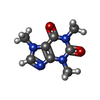
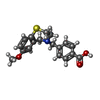
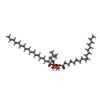







| #4: Chemical | ChemComp-CA / #5: Chemical | ChemComp-ATP / #6: Chemical | ChemComp-ZN / #7: Chemical | ChemComp-CFF / #8: Chemical | ChemComp-KVR / #9: Chemical | ChemComp-L9R / ( #10: Water | ChemComp-HOH / | |
|---|
-Details
| Has ligand of interest | Y |
|---|---|
| Has protein modification | Y |
-Experimental details
-Experiment
| Experiment | Method: ELECTRON MICROSCOPY |
|---|---|
| EM experiment | Aggregation state: PARTICLE / 3D reconstruction method: single particle reconstruction |
- Sample preparation
Sample preparation
| Component | Name: RyR1 in complex with calstabin-1 and calmodulin / Type: COMPLEX / Entity ID: #1-#3 / Source: NATURAL |
|---|---|
| Source (natural) | Organism:  |
| Buffer solution | pH: 7.4 |
| Specimen | Embedding applied: NO / Shadowing applied: NO / Staining applied: NO / Vitrification applied: YES |
| Vitrification | Cryogen name: ETHANE |
- Electron microscopy imaging
Electron microscopy imaging
| Experimental equipment |  Model: Titan Krios / Image courtesy: FEI Company |
|---|---|
| Microscopy | Model: TFS KRIOS |
| Electron gun | Electron source:  FIELD EMISSION GUN / Accelerating voltage: 300 kV / Illumination mode: FLOOD BEAM FIELD EMISSION GUN / Accelerating voltage: 300 kV / Illumination mode: FLOOD BEAM |
| Electron lens | Mode: BRIGHT FIELD / Nominal defocus max: 2000 nm / Nominal defocus min: 1000 nm |
| Image recording | Electron dose: 57.65 e/Å2 / Film or detector model: GATAN K3 BIOQUANTUM (6k x 4k) |
- Processing
Processing
| CTF correction | Type: PHASE FLIPPING AND AMPLITUDE CORRECTION |
|---|---|
| 3D reconstruction | Resolution: 2.45 Å / Resolution method: FSC 0.143 CUT-OFF / Num. of particles: 333010 / Symmetry type: POINT |
| Atomic model building | PDB-ID: 7TZC Accession code: 7TZC / Source name: PDB / Type: experimental model |
 Movie
Movie Controller
Controller



























 PDBj
PDBj


















